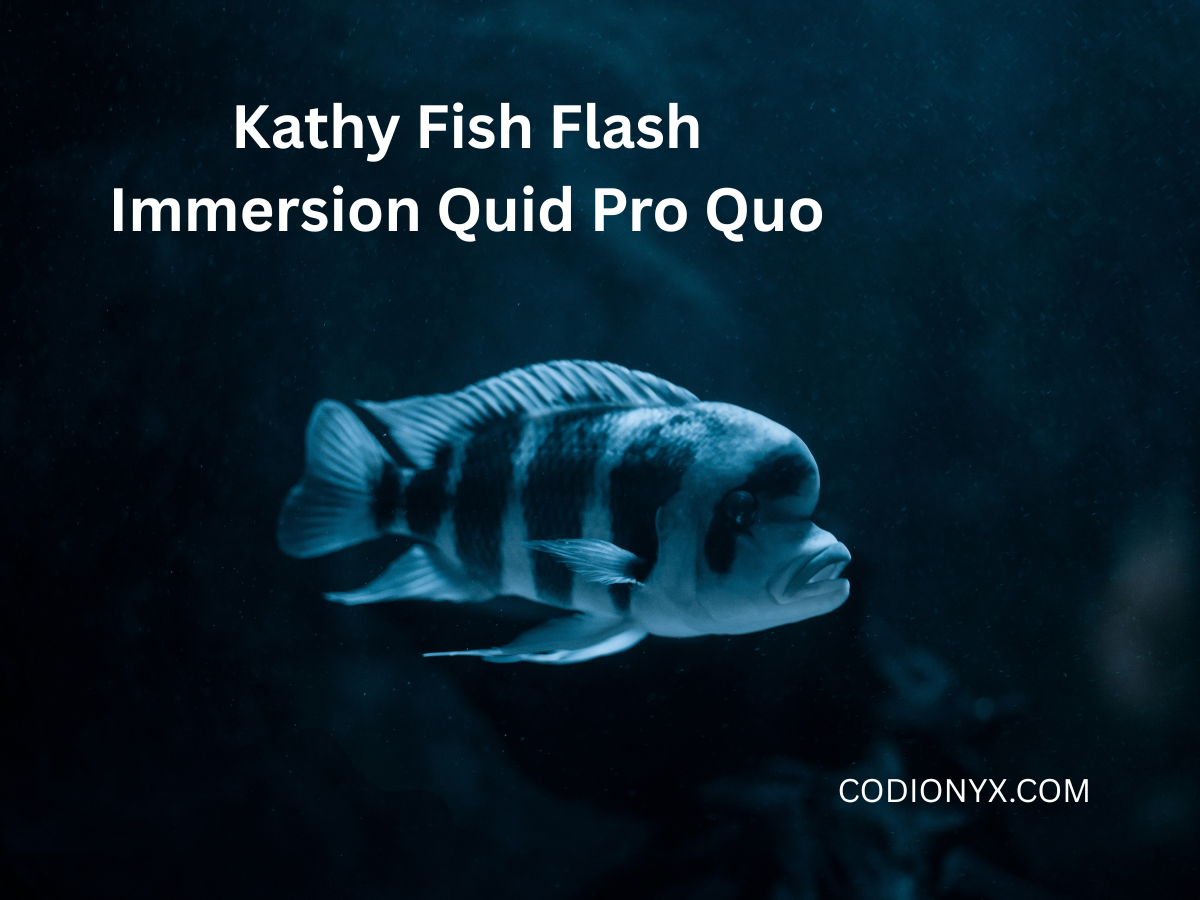Art of Kathy Fish Flash Immersion Quid Pro Quo.
INTRODUCTION.
Kathy Fish Flash Immersion Quid Pro Quo.is a form of writing that is characterised by its brevity, with stories typically being told in less than one thousand words. Despite this, flash fiction is capable of delivering a level of emotional depth, narrative depth, and meaning that is comparable to that of longer works. The name Kathy Fish has become synonymous with short fiction that is both vivid and emotionally profound, making her one of the most celebrated writers in this genre. Her “Flash Immersion” concept and her sophisticated use of quid pro quo storytelling stand out as remarkable examples of the distinctive characteristics that define her approach.
Within the scope of this article, Kathy Fish’s contribution to flash fiction, her Flash Immersion approach, and the manner in which the principle of quid pro quo enhances the emotional transaction between the tale and the reader are thoroughly investigated.
Is Kathy Fish Flash Immersion Quid Pro Quo a Real Thing?
In order to explain a method and strategy to writing Kathy Fish Flash Immersion Quid Pro Quo that engages readers on an emotional and visceral level from the very first phrase, Kathy Fish came up with the term “Flash Immersion.” When compared to protracted exposition, flash immersion is a technique that immediately thrusts the reader into a moment of intense emotional urgency.
Kathy Fish Flash Immersion Quid Pro Quo is not about giving a comprehensive story about one’s life; rather, it is about capturing a moment that you feel is significant and allowing everything else to fade into the background. This method thrives on the following:
Openings that are powerful and emotionally weighted
Language that appeals to the senses and immediately anchors the reader
An uncomplicated but compelling backstory
Sensational resonance that continues to linger
Subtle, unexpected, and soulful is the style that Kathy Fish is known for.
The stories written by Kathy Fish are renowned for the emotional depth they contain. They frequently start with something unremarkable, such as a family encounter, a calm realisation, or a recollection, and then quickly spiral into something that is intensely personal, surprising, or haunting.
Many of her flash fiction pieces have contrasting emotions, such as beauty and sorrow, love and loss, humour and gloom, and they are frequently contained within the same line. This is when the concept of “quid pro quo” comes into play.
The game of “Quid Pro Quo” in flash fiction: an exchange of feelings.
In Latin, the phrase “something for something” is translated as “quid pro quo.” In the context of the law or politics, it is referred to as a transactional exchange. Quid pro quo, on the other hand, is an emotive concept in Kathy Fish’s flash fiction. The following is the unwritten agreement that exists between the tale and the reader: “I will give you feelings of vulnerability, but I expect empathy in return.”
This is how the situation unfolds:
The reader is presented with an emotional truth when a character divulges something that is distressing.
The reader becomes more attentive and invested as a result of the story’s exclusion of certain facts.
It is possible for the writer to be ambiguous or raw. Reflection is the reward that is given to the reader.
Providing the reader with emotional honesty in exchange for the reader’s emotional attention is an effective narrative tactic.
Writers are interested in studying Kathy Fish’s Flash Immersion work.
Kathy Fish Flash Immersion Quid Pro Quo pieces are frequently studied by aspiring flash fiction authors because they are a masterclass in the following areas:
Accuracy: Each and every word is important
There is a sense of realism in even the persons who are not identified.
In a single sentence, a story might undergo a change in its emotional state.
The use of vivid, contemporary, and unexpected analogies in imagery
It is a common question among writers: “How can I make 500 words feel like 5,000?” They are shown how to do it by Kathy Fish.
Some examples of their work by Kathy Fish.
The following are some of Kathy Fish Flash Immersion Quid Pro Quo pieces that are well-known:
The story “Collective Nouns for Humans in the Wild” took the internet by storm since it was both poetic and politically explosive.
“Because Superman Doesn’t Exist” is a portrayal of family and brokenness that is both devastating and honest.
The Short Story “The Blue” is a poetic and concise piece of writing that employs sensory images to evoke feelings.
Her method for immersion and the emotional exchange she has with the reader are reflected in each and every contribution.
What Writers Have the Potential to Acquire.
In the event that you are a writer of Kathy Fish Flash Immersion Quid Pro Quo or simply enjoy reading short stories that have a significant impact, the following are some key lessons from Kathy Fish’s approach:
Commence with the impact: Refrain from warming up; instead, thrust the reader into the feeling.
In order to make fiction unforgettable, it is important to demonstrate the human cost.
Exert restraint: a diminished history can result in increased authority.
Believe in the reader and give them the opportunity to fill in the blanks and feel more connected.
Conclusion.
The contribution that Kathy Fish Flash Immersion Quid Pro Quohas made to the genre of flash fiction is not limited to the creation of beautiful stories; rather, she has been a pioneer in the development of an immersive storytelling technique that treats the reader as a collaborator in the emotional journey. Through the utilisation of Flash Immersion and the idea of quid pro quo, she transforms short fiction into something that is unparalleled in its impact.
The reader is presented with sensations that are brief but meaningful through her work. There is a blueprint for authors to follow in order to communicate more with less words, as well as for the creation of emotional truth that continues to reverberate long after the last line has been written.
FAQs
Q1: Who is Kathy Fish?
A: Kathy Fish is a renowned American writer known for her emotionally rich and lyrical flash fiction. She’s also a teacher and mentor, widely respected for her “Flash Immersion” workshops and contributions to the flash fiction genre.
Q2: What is Flash Immersion?
A: Flash Immersion is a storytelling approach developed by Kathy Fish that focuses on drawing the reader into the emotional core of a story immediately. It uses vivid language, strong openings, and emotional depth — often within just a few hundred words.
Q3: What does ‘quid pro quo’ mean in storytelling?
A: In Kathy Fish Flash Immersion Quid Pro Quo context, quid pro quo refers to the emotional exchange between the writer and the reader. The writer offers vulnerability, raw emotion, or truth — and in return, the reader engages deeply and empathetically.
Q4: Is Kathy Fish Flash Immersion Quid Pro Quo the same as short stories?
A: Not exactly. Kathy Fish Flash Immersion Quid Pro Quo is a subgenre of short fiction, typically under 1,000 words. It focuses on a single moment, emotion, or realization, whereas traditional short stories may be longer and more layered in plot and structure.
Q5: How can I write like Kathy Fish Flash Immersion Quid Pro Quo?
A: Kathy Fish Flash Immersion Quid Pro Quo Study her stories, pay attention to emotional pacing, use strong imagery, and start your story in the middle of the action. You can also enroll in her Flash Fiction workshops, where she teaches the Flash Immersion technique directly.








